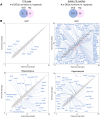Neonatal hyperoxia in mice triggers long-term cognitive deficits via impairments in cerebrovascular function and neurogenesis
- PMID: 36136598
- PMCID: PMC9663164
- DOI: 10.1172/JCI146095
Neonatal hyperoxia in mice triggers long-term cognitive deficits via impairments in cerebrovascular function and neurogenesis
Abstract
Preterm birth is the leading cause of death in children under 5 years of age. Premature infants who receive life-saving oxygen therapy often develop bronchopulmonary dysplasia (BPD), a chronic lung disease. Infants with BPD are at a high risk of abnormal neurodevelopment, including motor and cognitive difficulties. While neural progenitor cells (NPCs) are crucial for proper brain development, it is unclear whether they play a role in BPD-associated neurodevelopmental deficits. Here, we show that hyperoxia-induced experimental BPD in newborn mice led to lifelong impairments in cerebrovascular structure and function as well as impairments in NPC self-renewal and neurogenesis. A neurosphere assay utilizing nonhuman primate preterm baboon NPCs confirmed impairment in NPC function. Moreover, gene expression profiling revealed that genes involved in cell proliferation, angiogenesis, vascular autoregulation, neuronal formation, and neurotransmission were dysregulated following neonatal hyperoxia. These impairments were associated with motor and cognitive decline in aging hyperoxia-exposed mice, reminiscent of deficits observed in patients with BPD. Together, our findings establish a relationship between BPD and abnormal neurodevelopmental outcomes and identify molecular and cellular players of neonatal brain injury that persist throughout adulthood that may be targeted for early intervention to aid this vulnerable patient population.
Keywords: Behavior; Neurodevelopment; Neuronal stem cells; Neuroscience; Stem cells.
Conflict of interest statement
Figures
















References
-
- Lawn JE, Kinney M. Preterm birth: now the leading cause of child death worldwide. Sci Transl Med. 2014;6(263):263ed21. - PubMed
Publication types
MeSH terms
Grants and funding
LinkOut - more resources
Full Text Sources
Molecular Biology Databases

